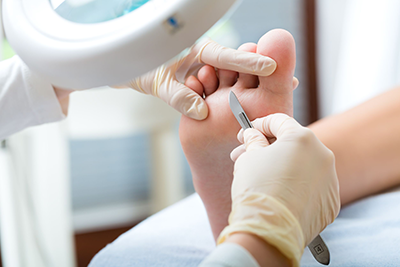Bunions
SIGNS AND SYMPTOMS
The symptoms of bunions include irritated skin around the bunion, pain when walking, joint redness and pain, and possible shift of the big toe toward the other toes. Blisters may form more easily around the site of the bunion as well. Having bunions can also make it more difficult to find shoes that fit properly; bunions may force a person to have to buy a larger size shoe to accommodate the width the bunion creates. When bunion deformity becomes severe enough, the foot can hurt in different places even without the constriction of shoes because it then becomes a mechanical function problem of the forefoot. PATHOPHYSIOLOGY
Bunions are sometimes genetic and consist of certain tendons, ligaments, and supportive structures of the first metatarsalthat are positioned differently. This bio-mechanical anomaly may be caused by a variety of conditions intrinsic to the structure of the foot – such as flat feet, excessive flexibility of ligaments, abnormal bone structure, and certain neurological conditions. These factors are often considered genetic. Although some experts are convinced that poor-fitting footwear is the main cause of bunion formation, other sources concede that footwear only exacerbates the problem caused by the original genetic structure. Bunions are commonly associated with a deviated position of the big toe toward the second toe, and the deviation in the angle between the first and second metatarsal bones of the foot. The small sesamoid bones found beneath the first metatarsal (which help the flexor tendon bend the big toe downwards) may also become deviated over time as the first metatarsal bone drifts away from its normal position. Arthritis of the big toe joint, diminished and/or altered range of motion, and discomfort with pressure applied to the bump or with motion of the joint, may all accompany bunion development. Atop of the first metatarsal head either medially or dorso-medially, there can also arise a bursa that when inflamed (bursitis), can be the most painful aspect of the process. TREATMENT
Bunions may be treated conservatively with changes in shoe gear, different orthotics (accommodative padding and shielding), rest, ice and medications. These sorts of treatments address symptoms more than they correct the actual deformity. Surgery may be necessary if discomfort is severe enough or when correction of the deformity is desired. ORTHOTICS
Orthotics are splints or regulators while conservative measures include various footwear like gelled toe spacers, bunion / toes separators, bunion regulators, bunion splints and bunion cushions. There are a variety of available orthotics including over-the-counter products and as necessary, custom-molded orthotics. Bunionectomy
Procedures are designed and chosen to correct a variety of pathologies that may be associated with the bunion. For instance, procedures may address some combination of:
At present there are many different bunion surgeries for different effects. The age, health, lifestyle and activity level of the patient may also play a role in the choice of procedure. Traditional bunion surgery can be performed under local, spinal or general anesthetic. A patient can expect a 6- to 8-week recovery period during which crutches are usually required for aid in mobility. Hardware may include absorbable pins, metal plates, screws, wires, and or rods that are used as fixation to allow the bone to heal. After recovery, long term stiffness or limited range of motion may occur in some patients. Visible or limited scaring may also occur for patients. |
Additional Services |
Additional Conditions and Treatments
Book Your Appointment Today |










